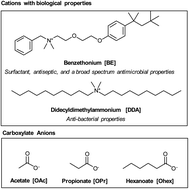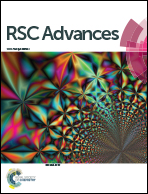Development of cellulose-based polymeric structures using dual functional ionic liquids†
Abstract
Carboxylate ionic liquids (ILs) combining benzethonium (BE) and didecyldimethylammonium (DDA) as cations have been explored to be used for the first time as dual functional solvents for microcrystalline cellulose (MCC) dissolution and, subsequently development of polymeric structures. Considering that some ILs can remain in the polymeric structures after phase inversion, these ILs can offer advantages such as antibacterial/antimicrobial response and ability to disrupt H-bonds. In this context, all tested ILs have been able to dissolve MCC up to a concentration of 4% (w/w), resulting in different polymeric structures, such as gel-like or films, depending on the type of IL and the ratio between MCC and IL. Furthermore, FTIR spectroscopy showed that some IL remains in the polymeric structures, which can enhance their application in the biomedical field.



 Please wait while we load your content...
Please wait while we load your content...